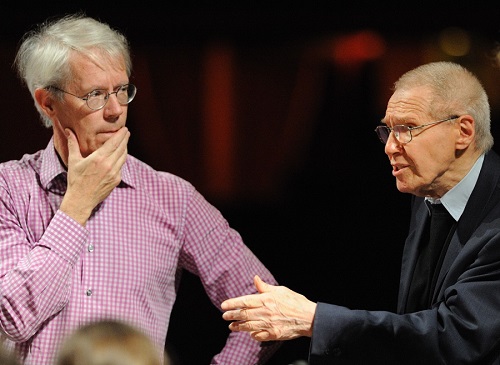Arranging Kurtág – An Interview with Olivier Cuendet
The renowned Swiss composer-conductor Olivier Cuendet has been working with György Kurtág for more than twenty years. One of the fruits of this cooperation, an ensemble version of …concertante…, was premiered on January 16, 2020, in Amsterdam with Asko | Schönberg Ensemble and was repeated in Washington D. C. two weeks later. Plans for a recording of Cuendet’s arrangement of Zwiegespräch for synthesizer and orchestra, and a premiere of a percussion version are also on the schedule.

How did you get acquainted with Kurtág’s music? What were its characteristics that most affected you?
Some 25 years ago I scheduled Grabstein für Stephan with the Kammerorchester Basel and, due to a common friend, I could work with Kurtág for the first time, as he assisted to some rehearsals and one concert. We understood each other very well from the first moment on, and he liked my way of performing Haydn! His deep roots in classical music and his natural and unique way to combine this heritage with atonality, together with his most innovative technique of composing are the most fascinating sides of Kurtág’s music for me. Another point is the extreme expressivity and organicity of each phrase and each piece he composes: there is no single note that doesn’t speak or tell something in his whole oeuvre!
Cuendet and Kurtág at a rehearsal in 2010 (Photo: Laurent Thion)
You’ve arranged three compositions by Kurtág for ensemble up till now: in two cases your arrangements are expansions of the original (Zwiegespräch and Games), the third one is a reduction (…concertante…). Why did you choose these works?
I can’t say that I chose these works, rather they chose me! When I discovered for myself Kurtág’s unique method of constantly reworking his previous compositions and producing new works out of older pieces, especially out of his piano music Játékok (Games), I asked him if I could try to make my own instrumental versions of some of his piano pieces with different technics and improvisation. I tried it with my ensemBle baBel and we performed it also in Budapest. After this first, mostly improvised attempt, he encouraged me to fix some of them into a score: the result was very far from improvisation but it kept the idea of ‘games’ from his Games (Játékok). In the meantime, György Kurtág Jr asked me if I could try to arrange Zwiegespräch and later …concertante… . Both works represent great music but suffered from balance problems: in Zwiegespräch between the string quartet and synthesiser, in …concertante… between the two soloists and a very large symphony orchestra. The challenge was to give the right space to the music and also to reorganise the musical material (Zwiegespräch) or to simplify it (…concertante…).
In the case of Zwiegespräch, you did not only prepare an instrumentation but a completely new arrangement using percussion instead of a synthesizer; this version is planned to be premiered at Luzern Festival. How did you come to this new version?
György Kurtág Jr’s contribution to Zwiegespräch, the synthesizer part, is partly pre-recorded and partly played live and no score exists for it. So nobody else can perform it but he himself. Therefore, I suggested replacing the synthesiser by a solo percussionist who would create a new dialogue with the orchestra. The idea is not to imitate the sounds of the synthesiser by percussion, but to transpose the musical intentions, the structure and the poetic of the music of Kurtág Jr that dialogues with his father’s music into another world of sounds. As the music of the son is not always fixed and can change from one performance to another, I gave the percussion soloist a lot of space for improvisation with certain rules and within a fixed structure. Thus, Zwiegespräch, a dialogue between father and son, could be extended to a dialogue between a solo performer and a full orchestra and also between written and improvised music.
What were your models by finding the sonority of Kurtágian ensemble music?
This is a delicate question. My first reaction was, of course, to study Kurtág’s instrumental work – I had conducted most of his orchestral and ensemble pieces –, and they are indeed a treasury of instrumentation! But Kurtág himself asked me for being less respectful and not to imitate his instrumental language, so, he wanted me to be impertinent, finding other sonorities and “correcting” what he had written. I could mention Les Noces by Stravinsky, popular music with accordion, Varèse or Stockhausen as my inspirations. But I tried mostly to forget the original and to find the best way and colour for each phrase, chord, and section of these works.
How could you work together with Kurtág?
Our work together has always been based on mutual trust and understanding; I have learned so much from many discussions and rehearsals with him, not only about his works but about music in general! Sometimes I send him pages of my arrangement and he makes comments, or I call him to ask a question. But the best way has always been to work directly with him, discussing the scores and recordings of the performances; it isn’t always easy because it is sometimes difficult to separate the problem due to the interpretation, to the recording and of the orchestration. He has always been extremely demanding, but first of all towards himself, criticising his own composition; he can very well say something one day and the contrary the next day; the problem is that he is right both times and you have to take a decision!
 Deutsch
Deutsch English
English Español
Español Français
Français Magyar
Magyar Polski
Polski Română
Română Slovenščina
Slovenščina 中文
中文